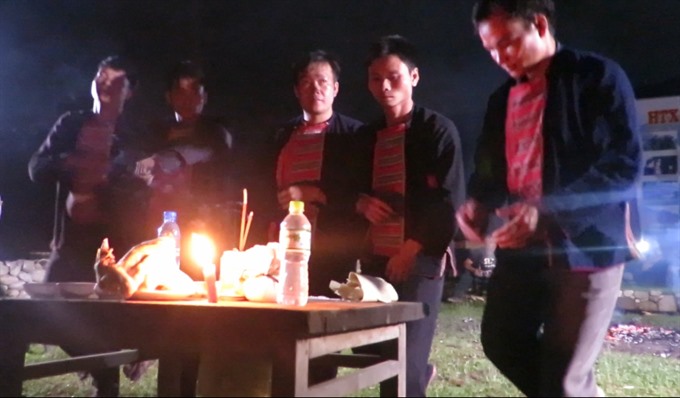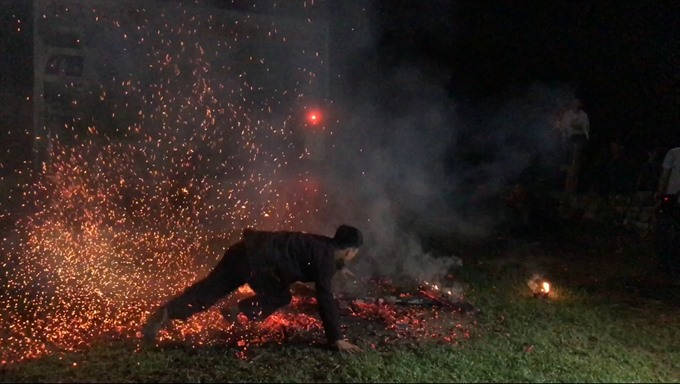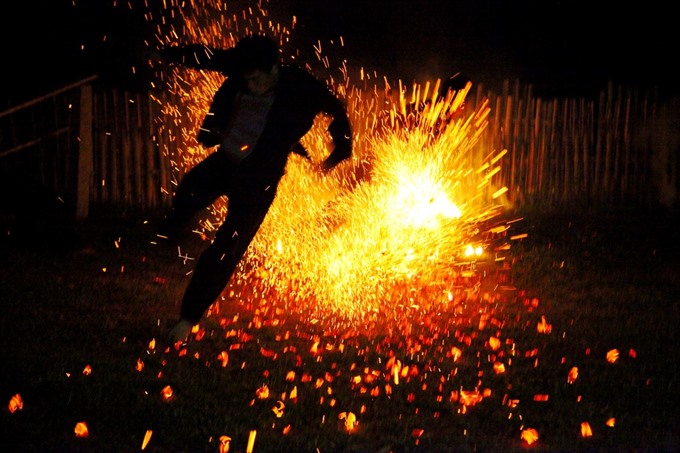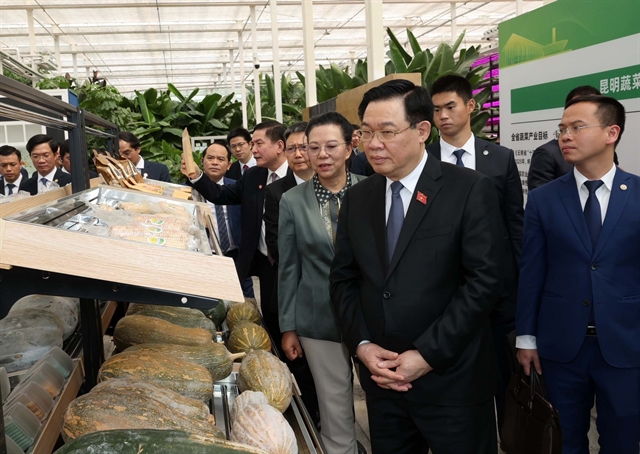 Features
Features

Fire dancing by the Red Dao ethnic group is a special cultural feature in Hà Giang Province. Strong and courageous men with bare feet shuffle around on burning coals, surprising tourists unaware that the rare practice exists in Việt Nam. Lê Hương and Hồng Vân explores the custom.
 |
| Higher power: The men go into a shivering trance in front of an altar before walking on fire. VNS Photo Lê Hương |
By Lê Hương & Hồng Vân
The northern province of Hà Giang is not only famous for its breathtaking mountains and terraced rice paddies, it is also known for the rich cultures evolved by 12 ethnic groups, including the Nùng, Dao and Mông.
The fire dancing ceremony of the Red Dao is an ancient custom in which supernatural power seems to strengthen the dancers, giving them strength and courage to dance on burning coal in bare feet.
The ceremony is ususally held at the end of the year or at the beginning of spring. Fire brings warmth, celebrates bumper harvest and pleases the gods, bringing prosperity and wiping away evils and illness.
At traditional festivals in early spring, men dance on fire to the beat of drums. To perform for tourists, shamans pray to the gods for permission.
To prepare for the ceremony, the head of the family assigns his family to display food and drink and display boiled and raw rice, rice wine, boiled cockerel, fresh-water from streams, pieces of white cotton cloth, incense, silver wrist bands, votive money, lamps and candles. All the offerings are displayed on a long wooden table.
One or more shamans may join in the ceremony. Each has his own duties during the complicated performance, which includes many stages and lasts for hours.
Triệu Văn Khiền, a shaman from the Dao community in Hà Giang’s Hoàng Su Phì District, said the appeals to the Fire God started with prayers for good luck, a peaceful and happy life, favourable weather, good health and the dispelling of evils.
As the shaman starts loudly calling, a big bonfire is lit. The shaman then reads the names of all men joining the dance. These are special names to introduce the men to the gods, not their real names.
All the men sit next to the shaman as they are presented to the gods. The shaman’s power is believed to flow to them.
 |
| Dance begins: A dancer runs onto the bonfire in bare feet. VNS Photo Lê Hương |
The bass sounds from bamboo instruments and drums and the deep sounds from bronze instruments seem to encourage the men. They seem controlled by a supernatutural power, shake their bodies, jump on one leg in front of the altar and then leap onto the burning coal.
They fall into a trance, dancing in bare feet on the red-hot coal, but showing no fear or pain.
They use their feet and hands to throw the burning coal into the surrounding area, putting fear into the audience.
Each of the men jumps around for three or four minutes on the coal before leaping on one leg towards the altar. They then sit down on a bench and let their feet continously pound the ground while their bodies shake.
“Before joining the ceremony, the men must keep their bodies clean and free from chemicals,” said Khiền, “The clothes they wear during the ceremony must be free from fat, oil or chemicals and washed by water only. They should stay far from women for three days before joining the holy ceremony, otherwise they may get burnt.”
Khiền said he had hosted the ceremonies for 30 years. His duty was asking the gods to give power to the men dancing, but he himself does not dance.
Phàn Dào Chòi, 27, a fire dancer said not everyone could take part in the performances, even if they were strong.
"This is the first time I have joined in. I felt very scared and excited when looking at the big bonfire,” he said. “Though my legs and arms trembled, I rushed to the fire. After the dance, I was still shaking, but highly conscious of things happening around.”
Chòi said he strictly followed the rules before joining the ceremonies and felt healthier after the dance.
"This is a valuable ritual handed down by my ancestors. I am happy to perform it for tourists here," he said. "If someone doubts the supernarural power helping Dao men, please try dancing on burning coal for an even shorter time to check what happens."
Triệu Vàn Quân, deputy chairman of Thông Phong Commune, who practised fire dancing until eight years ago, described his feeling during the dance.
"I felt normal before the dance, but when I started dancing on the coals, I felt as if I had drunk a lot of wine," he said. "I saw everything surround not clearly, just flimsy and yellowish. I did not feel scared at all. The bigger the fire is, the more it attracted me."
"The men dance for better crops and prosperity for the village," he said.
Quân said he used to dance before being handed down the skills to pray for the gods by his father. Since he was the man who prayed to the gods, he no longer was able to join in the dance. "That’s really magic," he said.
 |
| Sharing: A dancer kicks the coals up with his feet. VNS Photo Lê Hương |
Admiring the custom, Jean Luke, a tourist from the Netherlands, said he did not understand why the men were not burned. “It’s a miracle,” he said, “This land contains so many mysterious things for me to explore.”
Lê Ngọc, a tourist from Hà Nội, said the custom was unique. “I was scared as they danced onto the fire without any protection,” she said. “Their gods really protect them. I think no scientists can explain the phenonmenon.”
Trần Chí Nhân, deputy head of the district’s Culture and Information Department, said the fire dance of the Dao community had been handed down through many generations.
"Fire plays an important role in human life," he said. "It brings the living source to people, but if people cannot control it, it may cause serious disaster. The custom expresses Dao people’s desire to conquer fire through courage.
“In recent years, we have encouraged them to practise the custom, often at homestays, to entertain tourists,” he said. “Ecological and cultural tourism are key products in our district. We have established folk-art teams in villages and teams of fire dancers."
The custom is not only a symbol of the strength and strong will of Red Dao men, it’s also a unique, wild and mysterious practice that needs to be researched and preserved, he said. — VNS









